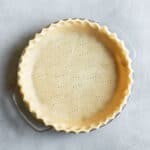
Vegan Gluten-Free Pie Crust (Easy & Oil-Free)
Servings:10 servings
This healthy vegan pie crust is SO delicious while defying all the rules! With no oil or gluten and just 4 ingredients, you won't believe how tasty, buttery, and crisp it is. And unlike traditional pie crusts made with flour and butter, this one isn't fussy. In fact, it's basically foolproof!Makes one 9-inch deep dish pie crust.
Ingredients
- 1 ½ cups fine blanched almond flour (168 g) - This is critical to the recipe. See Note 1 for tips on measuring. For nut-free, see this pie crust recipe.
- ½ cup white or brown rice flour (70 g) - Can also use a wheat flour here, if you don't need gluten-free.
- ⅓ cup tapioca starch (40 g) - See Note 2.
- ¼ teaspoon fine sea salt (use ½ teaspoon for savory pies)
- 2 tablespoons organic cane sugar (omit for savory pies) - Can use another granulated sugar such as date, coconut, or brown sugar.
- 5 to 7 tablespoons water
Instructions
- NOTE: the color of the pie crust is affected by the flour you choose. White rice flour creates a more pale-colored crust. Brown rice flour, whole-wheat, or spelt give the crust a slightly darker color.
- In a large bowl whisk together the almond flour, rice flour, tapioca starch, salt, and sugar.
- Add 4 tablespoons of water, and use a large spoon to thoroughly combine. Drizzle in 1 more tablespoons of water, and mix again. Refer to Notes section below and/or photos and video for help determining proper consistency. Be judicious with the water at this point. Add another 1 to 2 tablespoons of water (1 tablespoon at a time), if needed. When the dough is thoroughly moist and holds together when squeezed with your hand, form it into a ball.
- Place the dough on a large piece of parchment paper, about 13 inches long. Use your palm to gently flatten the dough into a disc. If the dough is too sticky, sprinkle with almond flour.
- With a rolling pin, use firm and steady pressure and slowly roll the dough until it's 12- to 13-inches in diameter. NOTE: It's important that the dough not be too thick, especially around the edges. After flipping onto the pie plate in the next step, you should have excess to trim away.
- Pick up the parchment paper and quickly flip the dough onto a 9-inch glass pie plate. Peel away the parchment. Without stretching the dough, use your fingers to gently press it into the bottom of the pie plate. Patch any holes or tears with excess dough from the edges.
- Use a knife to trim away the excess, and decorate the edges of the pie crust as desired (refer to post above for tips). Use a fork to poke vent holes in the bottom of the crust.
Baking Instructions:
- IMPORTANT: This crust doesn't brown exactly like traditional pastry. If you use white rice flour, the crust will still look somewhat pale even when it's done. Attempting to brown it further may result in an overbaked, hard crust. For pies with a no-bake filling, bake the pie crust in a preheated 350 degree F oven for 28 to 33 minutes or until crisp. Cool before filling.For pies that will be baked, like pumpkin or pecan, prebake the crust for 5 minutes before adding the filling. Cover the edges of the crust with foil or a pie shield if it begins to look too dry or crisp.
Video
Notes
Note 1: Measuring the Flours
If not using a scale, measure almond flour by lightly packing it into the measuring cup. For all other types of flour, whisk first to fluff it up. Then lightly scoop with a measuring cup, and use the flat edge of a knife to level off the excess.
Note 2: Tapioca Starch
Sometimes called tapioca flour. Note, the recipe previously called for ½ cup tapioca but I've reduced it slightly for improved texture and flavor.
Tips & Troubleshooting
- If the dough sticks to the rolling pin, sprinkle a little almond flour on top of the dough, and spread it around with your hand. Another option is to place a second piece of parchment paper on top.
- If you realize the dough is too crumbly once you start rolling it out, return it to the bowl and mix in 1 more tablespoon of water. *Remember, you don't have to worry about over-mixing it because we're not dealing with gluten. So really get in there with your hand, and distribute the water throughout.
Nutrition
Calories: 145kcal | Carbohydrates: 16g | Protein: 4g | Fat: 8g | Saturated Fat: 0.6g | Cholesterol: 0mg | Sodium: 60mg | Fiber: 2g | Sugar: 3g